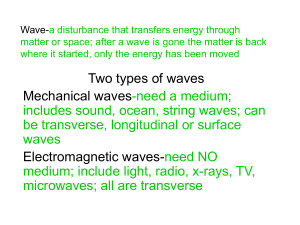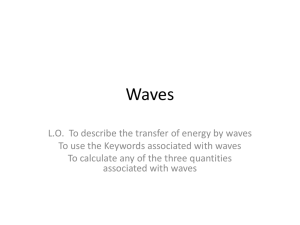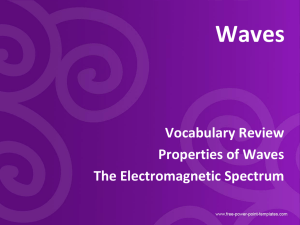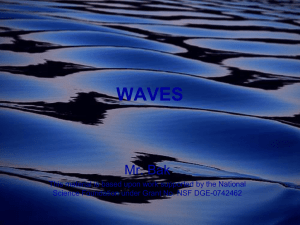17.2 Properties of Mechanical Waves
advertisement
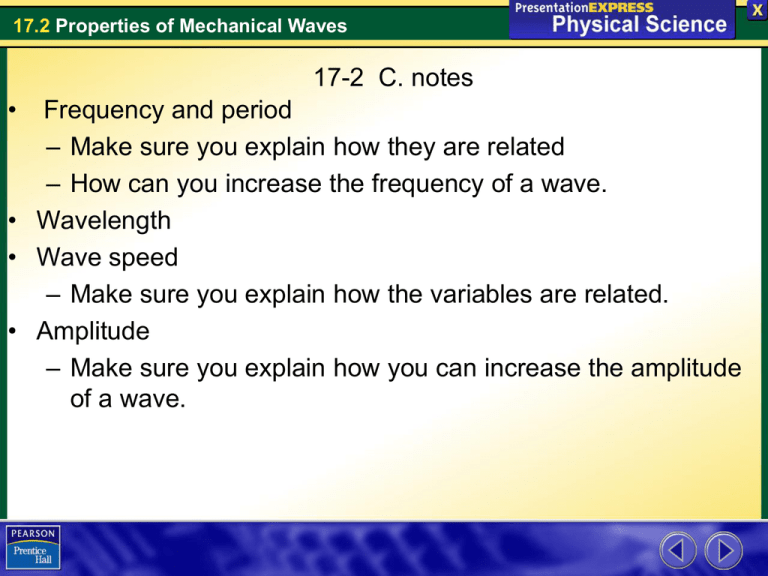
17.2 Properties of Mechanical Waves 17-2 C. notes • Frequency and period – Make sure you explain how they are related – How can you increase the frequency of a wave. • Wavelength • Wave speed – Make sure you explain how the variables are related. • Amplitude – Make sure you explain how you can increase the amplitude of a wave. 17.2 Properties of Mechanical Waves A surfer needs to understand the properties of waves. 17.2 Properties of Mechanical Waves II. Properties of Mechanical Waves A. Frequency and Period 1. Frequency- is the number of complete cycles of a wave in a given time created by periodic motion. a. A wave’s frequency equals the frequency of the vibrating source producing the wave. 17.2 Properties of Mechanical Waves 2. Periodic motion- any motion that repeats at regular time intervals. a. Period- The time required for one cycle. b. the frequency of the wave is measured in cycles per second, or hertz (Hz). 17.2 Properties of Mechanical Waves Frequency and Period A. A wave vibrating at one cycle per second has a frequency of 1.0 Hz. B. A wave vibrating at two cycles per second has a frequency of 2.0 Hz. Frequency = 1.0 hertz One cycle per second Frequency = 2.0 hertz Two cycles per second 17.2 Properties of Mechanical Waves B. Wavelength- the distance between a point on one wave and the same point on the next cycle of the wave. 1. Increasing the frequency of a wave decreases its wavelength. 2. For a transverse wave, wavelength is measured between adjacent crests or between adjacent troughs. 3. For a longitudinal wave, wavelength is the distance between adjacent compressions or rarefactions. 17.2 Properties of Mechanical Waves Wavelength Wavelength can be measured from any point on a wave to the same point on the next cycle of the wave. Long wavelength Rest position Short wavelength 17.2 Properties of Mechanical Waves C. Wave Speed 1. Formula: Speed = Wavelength X Frequency or Speed = Wavelength Wave’s period of vibration a. wavelength is in meters (m) b. frequency is in hertz (Hz) c. the units for speed are meters per second. (m/s) 2. If you assume that waves are traveling at a constant speed, then wavelength is inversely proportional to frequency. 17.2 Properties of Mechanical Waves 3. Examples: a. One end of a rope is vibrated to produce a wave with a wavelength of 0.25 meter. The frequency of the wave is 3.0 hertz. What is the speed of the wave? s= ? s 0.25 3.0 s w= .25 m s 0.75 m / s f= 3.0 Hz w f 17.2 Properties of Mechanical Waves b. What is the speed of a wave in a spring if it has a wavelength of 10 cm and a period of 0.2 s? w s p w= 10cm s= ? p= 0.2s 10 s 0.2 s 50cm / s 17.2 Properties of Mechanical Waves 4. The speed of a wave can change if it enters a new medium, or if variables such as pressure and temperature change. 5. For many kinds of waves, the speed of the waves is roughly constant for a range of different frequencies. 6. The wave with the lower frequency has a longer wavelength. 17.2 Properties of Mechanical Waves D. Amplitude – a wave’s maximum displacement of the medium from its rest position. 1. The more energy a wave has, the greater is its amplitude. 2. The amplitude of a transverse wave is the distance from the rest position to a crest or a trough. a. It takes more energy to produce a wave with higher crests and deeper troughs. 17.2 Properties of Mechanical Waves Amplitude The more energy a wave has, the greater is its amplitude. High amplitude Rest position Low amplitude 17.2 Properties of Mechanical Waves 3. The amplitude of a longitudinal wave is the maximum displacement of a point from its rest position. a. The more energy the wave has, the more the medium will be compressed or displaced. 17.2 Properties of Mechanical Waves Assessment Questions 1. While wading in shallow waters, six waves crash into your legs in a 24-second span. What is the frequency of the waves? a. b. c. d. 4 Hz 18 Hz 0.25 Hz 2 Hz 17.2 Properties of Mechanical Waves Assessment Questions 1. While wading in shallow waters, six waves crash into your legs in a 24-second span. What is the frequency of the waves? a. b. c. d. 4 Hz 18 Hz 0.25 Hz 2 Hz ANS: C 17.2 Properties of Mechanical Waves Assessment Questions 2. What is the speed of an earthquake wave if it has a wavelength of 2.3 km and a frequency of 3 Hz? a. b. c. d. 6.9 km 5.3 km 6.0 km 1.3 km 17.2 Properties of Mechanical Waves Assessment Questions 2. What is the speed of an earthquake wave if it has a wavelength of 2.3 km and a frequency of 3 Hz? a. b. c. d. 6.9 km 5.3 km 6.0 km 1.3 km ANS: B 17.2 Properties of Mechanical Waves Assessment Questions 3. Which wave property increases as the energy of a wave increases? a. b. c. d. period frequency wavelength amplitude 17.2 Properties of Mechanical Waves Assessment Questions 3. Which wave property increases as the energy of a wave increases? a. b. c. d. period frequency wavelength amplitude ANS: D

